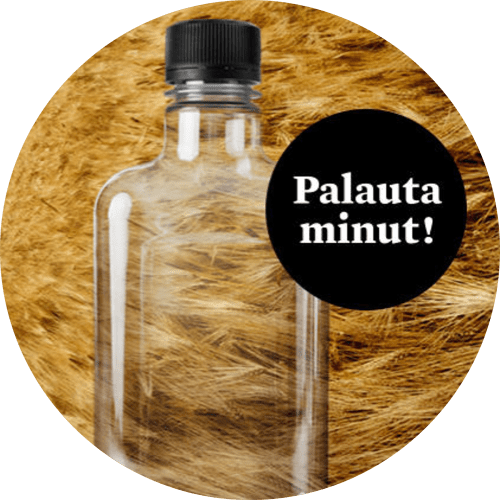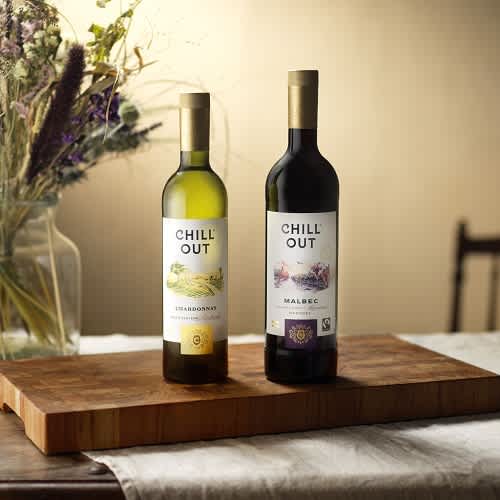
Leading in climate-smart packaging
Anora is the market leader in the sustainable packaging of wines and spirits in the Nordics. Packaging design and development plays an important role in Anora’s operations, given that we bottle over 130 million litres of alcoholic and non-alcoholic beverages every year. Good packaging design can reduce waste and carbon dioxide emissions significantly, helping us lessen the environmental impact of our products.
Anora invests heavily in product development and life-cycle thinking. We are especially proud of our pioneering efforts in sustainable packaging design and innovations. Our goal is to ensure all our packaging is recyclable and increase the use of more climate-friendly materials and recycled content.
Packaging design for the environment
Good packaging design can achieve substantial reductions in waste and carbon dioxide emissions. Alternative, and lighter, materials are used to an increasing degree and, for example, the weight of glass bottles is being reduced. This significantly reduces the carbon footprint resulting from the bottles’ manufacturing and transport.
Over the past few years, Anora has increasingly shifted from glass bottles to the use of alternative packaging materials, such as fully recyclable PET plastic bottles. With a 60–80% lower carbon footprint compared to glass bottles, our innovative PET bottles and recyclable Bag-in-Boxes offer better options for the environment and are at the core of Anora’s packaging strategy.
The plastic materials used by Anora have been selected according to the storage life requirements of the packaged content, taking into consideration production equipment as well as recycling and environmental issues. The plastic materials in the bottles have been approved for contact with foodstuffs which, in practice, means that they are carefully controlled, starting from their source materials.
rPET: plastic recycled from bottle to bottle
The carbon footprint of a bottle made from PET plastic can be only 40% of the footprint of a similar glass bottle. The reduction comes from the manufacturing process, the amount of plastic mass used and the energy consumed in manufacturing, and also from the efficiency of the logistics chain, for example. With rPET (where "r" stands for recycled), the carbon footprint is even smaller.
In 2020, Anora launched the first spirits bottles containing 25% rPET plastic. We have increased the share of rPET to 50% in spirits bottles. This pace exceeds the requirements and schedules outlined by the EU.
We have conducted thorough background work concerning the implementation of rPET plastic. For example, we have carried out research into such factors as the availability, quality and suitability of raw material. In addition, we needed to find a reliable raw material supplier and build a new, well-functioning delivery chain for rPET bottles.
More information on sustainable packaging types
PET bottles for spirits
Polyethylene terephthalate, i.e. PET, is a food-safe thermoplastic used particularly in the packaging industry. Beverage bottles and ovenproof plastic dishes, for example, are often made from PET. PET plastic is wear resistant and easy to recycle, almost endlessly. Moreover, thanks to its light weight and raw material manufacturing technology, PET plastic has a smaller carbon footprint than glass or other heavier materials.
Anora's rPET spirits bottles contain 25–50% of recycled rPET plastic. The recycled plastic used in the bottles comes from PET bottles returned by consumers. To ensure the safety and high quality of the material, Anora sources its rPET material from well-known markets and treats it by using a process of the highest quality standard.
Wine bottles from recycled plastic
In spring 2021, Anora launched the first wine bottle made completely from recycled PET plastic. As with the rPET bottles for spirits, the recycled material comes from plastic bottles returned by consumers against the deposit. Coloured rPET bottles can be returned by using the same recycling system as the colourless ones, so this material will be available for reuse.
Recyclable bag-in-box containers
Bag-in-box (BiB) containers consist of several elements made from different materials: the cardboard box, the wine bag, and the plastic tap and handle. The overall environmental impacts of BiB containers are already smaller than those of a traditional glass bottle, but the combination of various materials makes the packaging difficult to recycle from the consumer’s perspective.
In cooperation with its partners, Anora has developed new BiB containers in which the wine bag, tap and handle have been refined in terms of materials and colours so that they are more suitable for recycling. The valve of the tap is red, but other elements are colourless, making them recycling compatible. The wine bag does not include metalling, aluminium or nylon, which means that it too can be disposed of as plastic waste. In addition, the box will be made from materials obtained from FSC-certified, responsible sources. The BiB containers include recycling instructions to ensure all components continue their journey through recycling.
Lighter glass bottles
Glass remains a common packaging material for alcoholic beverages, especially in the premium product category. Often, the bottles of high-quality brands contain a considerable amount of glass material, which increases their environmental load. Reducing the weight of the bottle also reduces its carbon footprint.
Anora aims to make its glass bottles lighter in conjunction with packaging reforms and to increase the use of recycled glass. For example, a life cycle analysis conducted on O.P. Anderson Aquavit indicated that reducing the weight of a 0.35-litre glass bottle from 300 grams to 220 grams would reduce its emissions by 16% during the product’s life cycle.
A bottle’s journey
The new life of a glass or plastic deposit bottle begins with a clunk in the bowels of a reverse vending machine. After this, recycled glass bottles are crushed, cleaned and sorted according to their colour. They are reused in the production of glass wool or glass packaging, for example. Plastic deposit bottles are also returned to reverse vending machines, from where they also go to crushing, cleaning and sorting for the manufacture and reuse of raw materials.
Cans, plastic bottles and some glass bottles have a marking that identifies them as deposit bottles. If there is no deposit marking, you can check whether a glass bottle can be returned from the receipt or the shelf label.
The vending machine identifies the deposit from a bar code on the bottle's label, so in order to get the deposit back, the label must be intact. You will receive the receipt for your bottles from the machine to which you return them.
Glass bottles with no deposit – both coloured and clear – should be taken to glass recycling containers. There is no need to sort them, just throw them in. The caps or corks do need to be removed, but the labels, metal skirts and any other fixed parts can remain as they are. Once returned to recycling, most glass bottles are used for new bottles, but some of the material can even end up in aerated concrete.
Plastic bottles with no deposit belong in plastic recycling or mixed waste. Colourless plastic bottles return to service as, for example, preforms of new plastic bottles or even as raincoats. Coloured plastic bottles, on the other hand, can have a new life as backpacks or neckties. There is no need to remove plastic caps from plastic bottles, as they are also recycled.
Anora’s new, fully recyclable Bag-in-Box containers are easy to recycle along with other sorted household waste. First, detach the tap from the wine bag, rinse the bag with cold water and sort the plastic components, including the box handle, to plastic recycling. The box can be put in a cardboard recycling bin.

Sustainable packaging choices for wine buyers: recycled PET plastic bottle and Bag-in-Box
Anora's own wine brands are packed by Anora as close to the consumer as possible, reducing the carbon footprint of the products significantly. Bag-in-Boxes, or BiBs, is the primary format of wine packaging in Anora’s production. It is also the most sustainable option. Whereas a traditional glass bottle weights 500–600 grams, the BiB container, including the cardboard box and wine bag, weighs less than 140 grams. In addition, the typical glass bottle contains 75 cl of wine, but the typical size of a BiB container is three litres. One benefit of the glass bottle is better preservability. To offset this difference, wine bottles made from PET plastic feature an extra layer that prevents oxygen permeability.
In the spring of 2021, Anora introduced a wine bottle made fully from recycled PET plastic, or rPET. The raw material for these bottles comes from plastic deposit bottles returned by consumers. Replacing the raw material with recycled material drastically reduces the carbon footprint of the bottle, as the burden of oil refining can be excluded.
The carbon footprint of glass packages can also be reduced by using recycled material and lightening the bottles’ weight. However, even the lighter glass bottle's carbon footprint is approximately 60% higher than that of a PET plastic bottle.

Small, pocket-sized liquor and vodka flasks do not find their way to the reverse vending machines, despite their deposit. Anora launched a campaign for consumers to increase the return rate for small bottles.

Wine bottles made entirely from recycled PET plastic are a great new option for environmentally conscious wine lovers, as the carbon footprint of the bottle is less than 40% of that of a similar glass bottle.